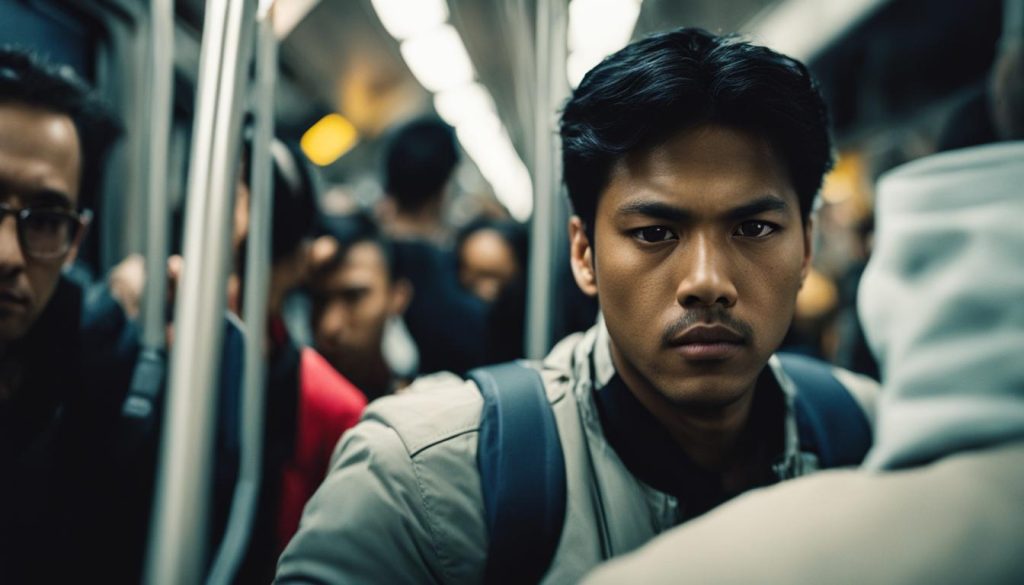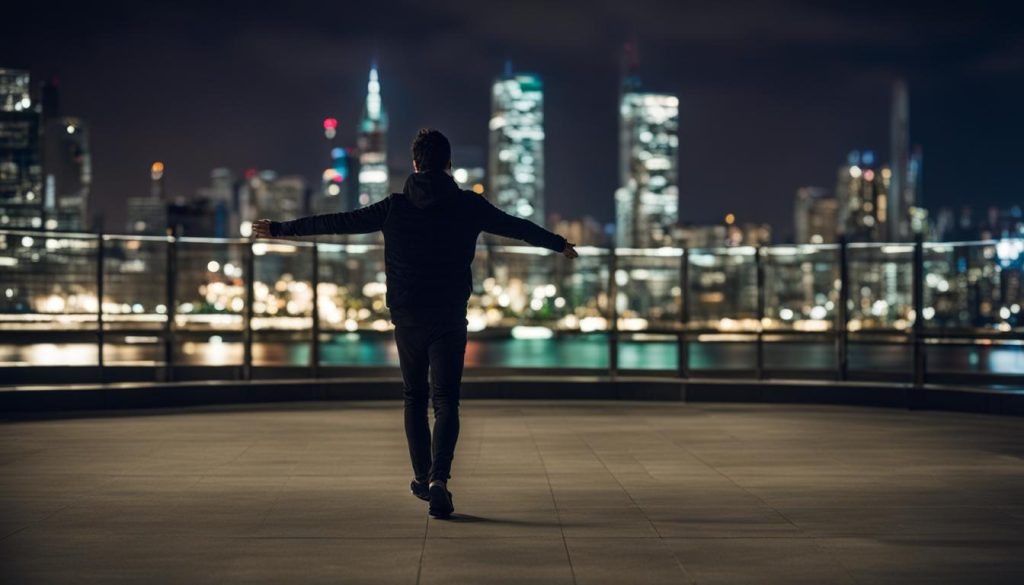Did you know that urban areas are becoming increasingly volatile, with crime rates on the rise? Learning urban escape evasion tactics is crucial for personal safety and survival in city environments.
In this article, I will provide you with essential techniques and strategies to help you navigate hostile urban environments with expertise and stealth. Whether it’s evading capture or avoiding dangerous situations, mastering these urban evasion techniques will give you the edge you need to stay safe.
Key Takeaways:
- Urban escape evasion tactics are essential for personal safety and survival in volatile city environments.
- By mastering urban evasion techniques, you can navigate hostile urban areas with expertise and stealth.
- Learning how to back away from potential threats and managing fear is crucial for effective urban escape evasion.
- The Gray Man mindset and blending in with the urban environment are key strategies for successful evasion.
- Preparation and adaptive thinking play vital roles in urban escape evasion.
The Public Transit Escape and Evasion Tactic

In the world of urban escape and evasion, one tactic that proves to be highly effective is utilizing public transit systems. Understanding the urban terrain and the intricate networks of public transport routes is crucial for executing a successful escape. By synchronizing our movements with the punctual rhythm of public transit, we can orchestrate a seamless evasion. Having knowledge of bus, tram, and train routes, stops, and stations is essential in navigating the cityscape.
Monitoring real-time data and utilizing technology allows us to enhance this tactic further. By staying updated with public transport schedules and disruptions, we can time our exits and utilize advanced evasion techniques such as connecting transports. This level of precision and agility maximizes our chances of successfully evading capture in urban environments.
The Gray Man Mindset and Principles

The Gray Man mindset is a crucial component of urban survival and personal security. It revolves around the ability to blend seamlessly into any urban environment, adopting behaviors, appearances, and tactics that avoid drawing attention.
Inconspicuousness is at the core of the Gray Man mindset. By appearing ordinary and unremarkable, individuals can navigate urban settings without raising suspicion. This involves dressing in neutral and unassuming clothing, avoiding flashy accessories or distinctive features that may attract unwanted attention.
Adaptability is another key principle of the Gray Man mindset. By constantly evaluating and adapting to the changing environment, individuals can remain flexible and responsive to potential threats. This includes adjusting one’s appearance, behavior, and tactics based on the specific urban setting and circumstances.
Situational awareness is crucial for personal security in urban environments. The Gray Man mindset prioritizes staying alert, observing one’s surroundings, and identifying potential risks or threats. By being aware of the people, sounds, and activities around them, individuals can anticipate and proactively avoid dangerous situations.
The Gray Man mindset and its principles are essential for enhancing personal security and survival skills in urban settings. By adopting inconspicuousness, adaptability, and awareness, individuals can navigate urban environments discreetly and effectively.
Backing Away as a Survival Skill
Backing away is a simple yet powerful technique that can be used in various situations to increase safety and reduce the risk of harm. By moving away from potential threats while maintaining eye contact, individuals can create distance and assess the situation. Knowing when and how to back away is crucial for avoiding dangerous situations and staying safe in urban environments.
When confronted with a potential danger, the instinctive response may be to freeze or panic. However, backing away allows for a more calculated retreat, providing valuable time to evaluate the situation and determine the best course of action.
Keeping eye contact while backing away serves multiple purposes. It displays confidence and asserts personal boundaries, signaling to potential adversaries that you are aware of their presence and will not be an easy target. Maintaining eye contact also allows for continued observation of the threat, enabling you to assess if it is escalating or if it is safe to disengage.
While backing away, it is essential to remain calm and composed. This will not only help manage fear and anxiety but also prevent actions that may further escalate the situation. Avoid sudden movements or gestures that could be misinterpreted as aggression, as this may provoke a dangerous response.
Remember, backing away is a survival skill that should be practiced and honed. Learning to recognize potential threats, understanding body language cues, and being mindful of your surroundings are all integral parts of mastering this technique.
Backing Away: Key Points

- Move away from potential threats while maintaining eye contact
- Create distance to assess the situation
- Stay calm and composed
- Avoid sudden movements or gestures
- Practice recognizing potential threats and reading body language cues
By incorporating backing away into your urban survival skill set, you enhance your ability to avoid danger and increase your chances of staying safe in potentially hostile environments.
Overcoming Fear in Evasion
Fear is a natural response that can hinder our ability to make rational decisions when faced with evasion scenarios. Understanding the fight or flight response and the role of anxiety is crucial in overcoming fear and effectively navigating urban escape and evasion situations. By practicing coping strategies and developing resilience, individuals can manage their fear and approach these scenarios with calm and rational decision-making.
The fight or flight response is an instinctual reaction that prepares our bodies to either confront a threat or flee from it. When faced with fear, our bodies release adrenaline, increasing heart rate, blood pressure, and alertness. However, in evasion situations, this response can sometimes impede our ability to think clearly and make strategic choices.
“The fight or flight response can be overwhelming, but by understanding its effects, we can learn to control our fear and act with clarity.”
Anxiety, often associated with fear, can also play a role in evasion scenarios. It is characterized by feelings of apprehension, unease, and worry. In these situations, anxiety can amplify our fear response and lead to irrational thinking or paralysis.
By practicing coping strategies, individuals can manage their fear and anxiety, allowing them to make calculated decisions during urban escape and evasion. Breathing exercises, visualization techniques, and positive self-talk can help alleviate fear and promote a sense of calmness and control.
Additionally, developing mental resilience is essential in overcoming fear. Building resilience involves exposing oneself to controlled levels of fear-inducing situations and gradually expanding comfort zones. By challenging oneself and gradually facing fears, individuals can build confidence and enhance their ability to navigate evasion scenarios.
The Role of Coping Strategies in Overcoming Fear
Coping strategies are techniques used to manage and mitigate fear and anxiety. These strategies can be learned and practiced, empowering individuals to overcome their innate fear response. Some effective coping strategies include:
- Deep Breathing: Taking slow, deep breaths helps activate the body’s relaxation response, reducing physiological symptoms of fear and anxiety.
- Visualization: Imagining successful outcomes and visualizing oneself overcoming fear can boost confidence and reduce anxiety.
- Positive Self-Talk: Using affirmations and positive statements can help reframe negative thoughts and instill a sense of empowerment.
- Progressive Muscle Relaxation: This technique involves systematically tensing and relaxing different muscle groups, promoting relaxation and reducing anxiety.
By regularly practicing these coping strategies, individuals can develop the skills necessary to overcome fear and approach evasion scenarios with clarity and composure.
The Fusion of Tradecraft and the Gray Man Mindset
Tradecraft, the skillset developed by covert operatives, can be adapted for everyday use to enhance the Gray Man mindset and improve personal safety. By incorporating tradecraft techniques into the Gray Man mindset, individuals can navigate urban environments discreetly and intelligently, ensuring everyday safety.
Understanding Surveillance
A fundamental component of tradecraft is understanding surveillance techniques. By recognizing the signs of surveillance and employing counter-surveillance measures, individuals can stay one step ahead of potential threats. This knowledge allows for proactive decision-making and reduces the risk of being detected.
Counter-Surveillance Measures
Implementing counter-surveillance measures is crucial for maintaining personal safety. Techniques such as conducting sweeps for hidden cameras, varying daily routines, and using anonymous communication methods help to protect sensitive information and prevent potential threats from gathering intelligence.
Personal Information Protection
Tradecraft emphasizes the importance of safeguarding personal information to prevent it from falling into the wrong hands. By practicing diligent cybersecurity measures, individuals can protect their digital footprints and avoid being targeted. This includes using strong passwords, encrypting communications, and regularly updating privacy settings on social media platforms.
Mental Resilience
Mental resilience is a key attribute that tradecraft fosters. By developing mental strength, individuals can stay calm and composed in high-pressure situations, enabling them to make sound decisions and effectively navigate urban environments. Techniques such as mindfulness practices, stress management strategies, and mental preparedness exercises contribute to enhancing mental resilience.
“The fusion of tradecraft and the Gray Man mindset allows individuals to operate in urban environments with heightened awareness and discretion, significantly improving personal safety.”
By integrating tradecraft techniques into the Gray Man mindset, individuals can elevate their urban survival skills and achieve everyday safety. Understanding surveillance, implementing counter-surveillance measures, protecting personal information, and developing mental resilience are all integral components of this fusion. By mastering these skills, individuals can confidently navigate urban environments with discretion and intelligence.
Blending In and Adapting to Urban Environments
Successfully evading capture in urban environments requires the strategic skill of blending in with your surroundings. To accomplish this, it is essential to wear neutral clothing that doesn’t attract unnecessary attention. Adapting your clothing style to match the urban environment can help you seamlessly merge with the crowd. Additionally, controlling your behavior and avoiding actions that draw notice are crucial for maintaining a low profile.
Moving with low profile movements is another key aspect of blending in. By avoiding any conspicuous or attention-grabbing behaviors, you can navigate the urban environment unnoticed. This includes being mindful of your body language, keeping a relaxed posture, and moving with purpose and confidence.
Maintaining constant vigilance is vital when blending in and adapting to urban environments. By staying aware of your surroundings and monitoring the people and activities around you, you can quickly detect any potential threats or suspicious behavior. This heightened awareness enables you to respond swiftly and appropriately to changing situations.
The Importance of Escape Routes and Minimal Engagement
A crucial part of blending in and adapting to urban environments is planning escape routes in advance. Familiarize yourself with the layout of the area, identifying alternative routes and safe havens that can be utilized if needed. This proactive preparation ensures you can swiftly navigate the urban setting and evade capture.
Add to your strategy by engaging minimally with others. While it’s important to remain aware of your surroundings, limiting unnecessary interactions helps to maintain a low profile. Avoid drawing unnecessary attention by keeping conversations brief and nonchalant and refraining from divulging personal information.
Blending in and adapting to urban environments is a critical skill for successful evasion in city settings. By blending seamlessly into the crowd, moving with low profile movements, maintaining constant vigilance, having escape routes planned, and engaging minimally with others, you can increase your chances of staying unnoticed and evading capture in any urban setting.
Evasion Techniques and Adaptive Thinking
When it comes to urban survival strategies, evasion techniques and adaptive thinking are essential skills to master. Alongside the effective strategy of backing away, there are various tactics that individuals can employ in urban environments to ensure their safety and increase their chances of evading capture.
One technique is running. When faced with immediate danger or pursuit, a quick burst of speed can provide a valuable advantage. It is important to be aware of the surroundings, identify potential escape routes, and utilize the urban landscape to create obstacles for pursuers. Running can be combined with the use of alleys, staircases, or even rooftops to quickly change direction and throw off anyone following.
Hiding is another evasion technique that can be highly effective. When evading capture, finding a hidden location, such as a secluded alley, abandoned building, or densely populated area, can provide temporary respite and allow individuals to assess the situation. It is crucial to stay still, keep quiet, and blend into the environment to avoid detection.
Using the environment and everyday items for self-defense or emergency situations is also a valuable skill. Improvised weapons, such as a sturdy stick or a rolled-up newspaper, can be used to defend oneself if confronted by an assailant. Additionally, knowledge of urban structures, such as fire escapes or parkour techniques, can be utilized to access higher ground or escape through unconventional routes.
Adaptive thinking plays a pivotal role in urban survival. It involves creatively utilizing resources available in the environment to overcome obstacles. This could include using public transportation as a means of escape, finding alternative routes through back alleys or side streets, or blending in with a crowd to go unnoticed. Being able to think on one’s feet and adapt to rapidly changing circumstances is crucial in evasion scenarios.
Developing mental resilience is equally important in urban survival. The ability to stay focused, think clearly under pressure, and make quick decisions can mean the difference between success and failure. By practicing and honing these skills, individuals can navigate urban settings with agility and adaptability, effectively evading capture.
“In urban survival, it is essential to stay one step ahead of potential threats. By employing evasion techniques and embracing adaptive thinking, individuals can outmaneuver adversaries and ensure their safety.”
In summary, mastering evasion techniques and embracing adaptive thinking are integral to urban survival strategies. Running, hiding, and utilizing the environment for self-defense can provide individuals with the necessary tools to evade capture in dangerous situations. Additionally, adaptive thinking allows for creative problem-solving and resource utilization. By honing these skills and developing mental resilience, individuals can effectively navigate urban environments, ensuring their safety and increasing their chances of survival.
Preparing for Urban Escape and Evasion
In the realm of urban escape and evasion, preparation is paramount. By taking proactive measures and cultivating an adaptive thinking mindset, individuals can enhance their chances of successfully evading capture in emergency situations. In this section, we will delve into key aspects of urban escape and evasion preparation, including understanding surveillance, minimizing the digital footprint, recognizing elicitation attempts, and pre-planning escape routes.
Understanding Surveillance
One of the first steps in urban escape and evasion preparation is developing a comprehensive understanding of surveillance techniques. By familiarizing oneself with common surveillance methods, individuals can identify potential threats and adjust their actions accordingly. This knowledge becomes particularly valuable when navigating through crowded urban environments, where surveillance is more prevalent and inconspicuous.
Minimizing the Digital Footprint
In today’s digital age, reducing one’s digital footprint is essential for urban escape and evasion. This entails practicing good privacy and security habits, such as using encrypted communication platforms, regularly changing passwords, and being cautious about sharing personal information online. By minimizing the digital trace we leave behind, we decrease the chances of being tracked or monitored.
Recognizing Elicitation Attempts
Elicitation is a technique employed by adversaries to gather information from unsuspecting individuals. Developing the ability to recognize and thwart elicitation attempts is crucial for maintaining operational security in urban environments. By staying vigilant and questioning the motives of others who show an unusually keen interest in personal or sensitive information, we can protect ourselves from potential threats.
Pre-Planning Escape Routes
Having predetermined escape routes is an essential aspect of urban escape and evasion preparation. By scouting and mapping out potential exit routes in advance, individuals can expedite their escape should the need arise. This preemptive planning allows for quick and effective decision-making, reducing the risk of getting caught in dangerous situations.
By dedicating time and effort to urban escape and evasion preparation, individuals can significantly increase their chances of successfully eluding capture in emergency scenarios. The combination of understanding surveillance, minimizing the digital footprint, recognizing elicitation attempts, and pre-planning escape routes forms a solid foundation for navigating urban environments with confidence and agility.
Conclusion
Mastering urban escape evasion tactics is crucial for survival in hostile city environments. By implementing the Gray Man mindset, utilizing backing away as a survival skill, and incorporating tradecraft techniques, individuals can significantly enhance their personal security and improve their chances of evading capture in urban settings.
The Gray Man mindset allows for inconspicuous navigation in urban environments by adopting behaviors, appearances, and tactics that avoid drawing attention. By blending in and adapting to the surroundings, individuals can minimize the risk of detection.
Backing away is a simple yet powerful technique that creates distance from potential threats and enables a better assessment of the situation. The ability to recognize danger and respond appropriately is essential for avoiding harm in urban environments.
Furthermore, by incorporating tradecraft techniques, such as understanding surveillance, personal information protection, and mental resilience, individuals can enhance their urban survival strategies. This combination of skills, when understood and practiced, provides individuals with the necessary tools to navigate hostile city environments successfully.
